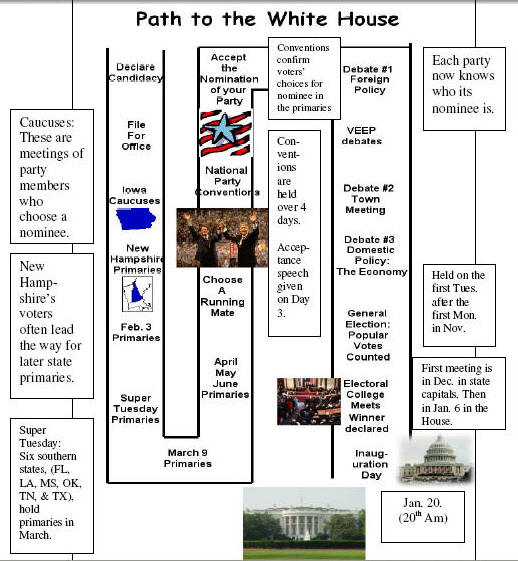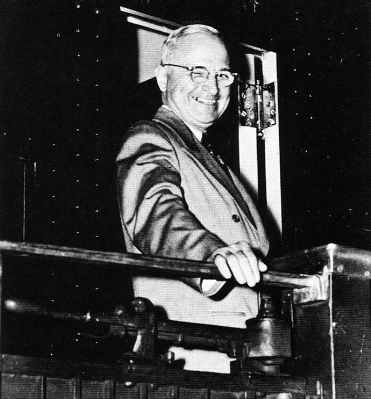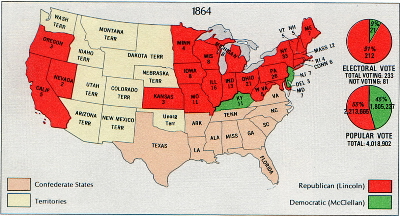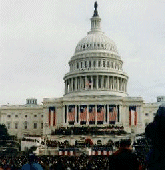|
|
Using Current Events to Understand Elections |
Current Events as History
The Election of 2008 has passed from
current events into the pages of recent American history. Depending on your age
and what you were doing, you may remember some of the key events of the
election. There are a variety of sources students of this election
can use to bring back the events that helped shape the outcome on November 4,
2008. Students and teachers interested in politics will most likely use the
Internet to locate information on the candidates, the electoral process, and on
the platforms of the major political parties. Using the print media is also a
good choice if you have access to an archive of recent news magazines and
newspapers. Commemorative issues of the election of 2008 and the inauguration of
Barack Obama in January of 2009 have appeared, and some of these are becoming
more valuable as time goes on.
Primaries and Caucuses
Presidential elections in the United
States consist of a two-phase process: primary elections and the general
election, but the process is much more complex than that. Each of the two
major political parties in the United States must determine who of their
candidates will be the party's nominee. This process is achieved through a
series of preliminary elections called primary elections (also called direct
primaries). Some states have preliminary elections called caucuses. These are
meetings of the party membership in public places such as schools, town halls
and private homes. Voters demonstrate who their first choice for president is.
If that candidate gets at least 15% of the vote, then he or she is still
"viable" and can be assigned a proportionate number of delegates to
the party's convention. If the candidate failed to achieve
"viability," his or her supporters are persuaded to join the camp of
another candidate. The final tally is then taken. The caucus system can be
confusing and has a tendency to eliminate candidates who come to the election
with minimal support. In primaries, by contrast, a candidate can continue to run
as long as he or she has the funds to sustain the campaign. The first state to
reveal its choice is that of Iowa, which has a caucus that is seen as a
critical part in any candidate's campaign because it points to whom the party's
voters see as their front runner.
Primary elections can also be subject to rules assigned to them by state legislatures. In some states, voters can only vote for candidates of the party to which they belong. This type of primary is called a closed primary. Other states allow voters of different parties to vote for candidates outside of their own party. These types of elections are called open primaries. Open primaries are less of an accurate portrayal of how a given party feels about its potential nominee because it involves voters from other parties involved in cross-party voting, an action that could be used as a strategy for electing the less desirable candidate in the other party.
The Campaign Begins
The primary election cycle of this
presidential election started in early January, 2008, but some of the candidates
declared their intention to run as early as 2006. Candidates often form
exploratory committees to see what sort of funding it would take to launch a
campaign and to gauge how much support there is for their candidacy. Primary
elections take place on a state-by-state basis throughout what seems to be the
first half of the election year. The New Hampshire primary is always seen as a
critical event in the selection process because it gives further definition to
the way that each party is leaning regarding its candidates. States that follow
may be influenced by New Hampshire's voters in its primary. A large number
of states cast their primary votes on what is called "Super Tuesday."
After Super Tuesday, a winner for each party's nomination tends to emerge, but
the process is not quite over after that important day.
Making the Delegates Count
Once each state's party membership has
determined its favorites, the candidates are given a number of delegates that
will vote for their declared winner at their party's convention. Each party
determines the number of delegates needed to win the nomination. The Democrats
assigned delegates on a proportional basis, which led to a close contest between
Hillary Clinton and Barack Obama. In the end, Obama had the 2,118 delegates
needed to win with 2,201, while Hillary Clinton came in a close second with
1,891. The Republican Party assigned its delegates on a winner-take-all system
much like the one that shapes the Electoral College in the general election.
John McCain clinched his nomination in April because he had reached the magic
number of 1,191 much sooner than did either of his Democratic rivals.
The Nation Decides
The second phase of the election
process is centered around the general election in November. Once each party has
made its nomination official at its national convention, the candidates must
campaign nationally and they will engage in a number of televised debates. The
candidate's acceptance speech at the convention is always closely watched, in
part for its content and policy statements, but also because it reveals a
candidate's speaking style and public persona. The Democratic National
Convention of 2004 was not as important for nominee John Kerry as it was for the
then-little known state Senator from Illinois, Barack Obama, who gave the
keynote address. Many experts say that it was at that event that the nation came
to discover Obama's intellect and oratorical skills. He still needed to be
elected to the US Senate at that point, but it was the start of a meteoric
career in American national politics.
The Electoral College
After each party's convention is complete,
the candidates will travel the nation and broadcast advertisements that will
hopefully educate the voters as to their positions on the issues. Candidates
must study the electoral map carefully to see where their efforts will garner
the greatest amount of support in states that carry the highest number of
electoral votes. The results of the electoral vote are influenced by the number
of people who vote for a candidate. that number is called the popular vote. The
candidate who wins the popular vote in a state receives all of the electoral
votes of that state. Election-watchers say that the winning candidate has
"carried" a given state," and all of the party's electors will
then cast their vote for the winner of the election in that state. Each state's electoral
number is determined by the number of people that state sends to Congress, which
in turn, is a combination is based on the number of people who live in that
state (resulting in representation in the House of Representatives) and the two
senators for that state. Larger states with big cities have more members in the
House of Representatives, so those states have a greater number of electoral
votes. Rural states such as Montana and Alaska have the minimum number of
electoral votes, which is three (two senators and one "at-large" House
member). The District of Columbia was given three electoral votes in 1961 by the
23rd Amendment to the Constitution. The total number of available electoral
votes is 538. A majority of those votes, the ones that decide who will be
president, is 270. That number is the number a candidate must win in order to be
declared the winner by the President of the Senate (the vice-president) in
January following the election.
The Public Agenda
The American public makes a political
choice during presidential elections in part by what the electronic and print
media place into the public arena. The public agenda is made up of the issues
that the electorate wants to the government to face in its decision making
process, something called public policy. The direction of the government in
respect to the goals that it has set helps determine public policy. We see how
public policy becomes put into reality through the images, headlines, and
current events found in the newspapers, magazines, websites, and news broadcasts.
The process of choosing a leader and elected legislature on all levels of
government has undergone a considerable evolution as technology has improved and
the electorate has become more educated. These elements work together to make up
American modern democratic system.




